 The subject of our dissertation was born in Brooklyn during 1930 as Robert Oscar Blechman . . . or some such variation on that theme.
The subject of our dissertation was born in Brooklyn during 1930 as Robert Oscar Blechman . . . or some such variation on that theme.
Wikipedia touts R. O. Blechman thusly:
American animator, illustrator, children’s-book author, graphic novelist and editorial cartoonist whose work has been the subject of retrospectives at the Museum of Modern Art and other institutions. He was inducted into the Art Directors Hall of Fame in 1999.
Every word of that is true except ‘animator’, because R. O. Blechman is not an animator. Profiles, bios, and write-ups repeatedly claim he is. Why?
 His parents supported Bob Blechman’s artistic leanings and he attended the High School of Music and Art, going on to Oberlin College. Upon graduating in 1952 he humped his portfolio around to advertising agencies in Manhattan. During all that, Bob wrote and illustrated a book in his parents’ kitchen. Blechman hand lettered THE JUGGLER OF OUR LADY, knocking the whole thing out quickly. Henry Holt agreed to publish it. Uncle Sam had Private Blechman in the Army before THE JUGGLER OF OUR LADY saw release. Fortunately he avoided combat in the Korean War, being stationed in Asbury Park, New Jersey to do medical illustration.
His parents supported Bob Blechman’s artistic leanings and he attended the High School of Music and Art, going on to Oberlin College. Upon graduating in 1952 he humped his portfolio around to advertising agencies in Manhattan. During all that, Bob wrote and illustrated a book in his parents’ kitchen. Blechman hand lettered THE JUGGLER OF OUR LADY, knocking the whole thing out quickly. Henry Holt agreed to publish it. Uncle Sam had Private Blechman in the Army before THE JUGGLER OF OUR LADY saw release. Fortunately he avoided combat in the Korean War, being stationed in Asbury Park, New Jersey to do medical illustration.
THE JUGGLER OF OUR LADY was a critical and commercial success by the time Blechman left the Army. John Hubley admired its uniqueness and deep spirituality, combined with the simplicity of Blechman’s graphic style. Hubley invited him to join Storyboard Inc.’s fledgling New York branch as a layout artist in late 1955. In March of 1956 Bob Blechman joined Screen Cartoonists Guild Local 841.
Connections were made. Gene Deitch was Bleckman’s supervisor at Storyboard, and they got on well. Hubley sent Blechman on assignment to Hollywood where he worked with animator Willis Pyle. And yet, Blechman referred to his time at Storyboard as “an experiment that failed miserably”. So, when Gene Deitch was put in charge at Terrytoons, Blechman warily took another turn at the business, this time as a designer, with an office right near Len Glasser.
It’s important to note this is a period when Terrytoons was in the midst of an internal power struggle with Deitch’s faction pitted against producer Bill Weiss and his entrenched old guard. In the name of further clarity, I should relate that Bob Blechman is a soft-spoken, cosmopolitan fellow. Len Glasser claims that Blechman sometimes walked into his office to take a pencil from Glasser’s desk and snap it in two, muttering something about how angry that place made him. These excessively violent outbursts surprised Glasser, because Bob Blechman is a gentleman . . . but not an animator.
Gene Deitch decided to make THE JUGGLER OF OUR LADY as a cartoon, giving it the full Cinerama treatment. Al Kouzel did the animation, because R. O. Blechman is not an animator. Released in 1957, THE JUGGLER OF OUR LADY played well at film festivals and art-house theaters. Boris Karloff’s sensitive narration gave it a level of sophistication absent in most cartoons. The British Film Academy nominated it for an award.

Then Bill Weiss dropped the axe, forcing Deitch and his faction out of Terrytoons. C’est la vie! Blechman illustrated advertisements and sold work to different publications, mainly cartoons. ESQUIRE Magazine sent him to Yugoslavia. In 1958 Blechman did a cover for Harvey Kurtzman’s Magazine HUMBUG. John Hubley released A DATE WITH DIZZY, featuring clips from several past Storyboard commercials. Bill Littlejohn had animated some sketches Blechman left behind at Storyboard.

So, John Hubley was the first to infer R. O. Blechman is an animator, which he isn’t. And yet, the medium held an allure for Bob Blechman. The United Nations Association’s magazine VISTA printed a story titled THE EMPEROR’S NEW VISIT, which intrigued Blechman enough to try his hand at directing an animated version. Willis Pyle, now in New York, ran a studio from the Abbey-Victoria Hotel. Blechman and Pyle made a film of THE EMPEROR’S NEW VISIT, screening it at the Aspen Design Conference when Blechman was guest speaker.
Not thrilled with the results, Blechman and Pyle none-the-less took another shot with THE EMPEROR’S NEW ARMOR. The public grew more familiar with R. O. Blechman’s sparse, squiggly drawing style through constant exposure in the print media. His real ambition on that front was to do a cover for THE NEW YORKER Magazine, but no luck so far. He did some layouts and design work for Elektra Films, a studio noted for their innovative TV commercials.
Elektra paired Blechman with different animators for different projects. Phil Kimmelman found himself in a room with Blechman for one project. Blechman drew a few samples in his signature style and left Kimmelman alone to practice simulating it. When Blechman returned he picked out a sketch from those scattered across the table. Blechman critiqued the piece, telling Kimmelman he missed the mark, expressing doubts that this could work. Kimmelman pointed out that Blechman was holding one of Blechman’s own sketches. They both laughed and got along fine after that.
Shamus Culhane met with Blechman in 1966 about Paramount Cartoons adapting some of Blechman’s material, but it never occurred. That year R. O. Blechman plugged into the cultural zeitgeist ( or should I say linguee? ), with the heart-warming interstitial CHRISTMAS BIRDS for the CBS Network.
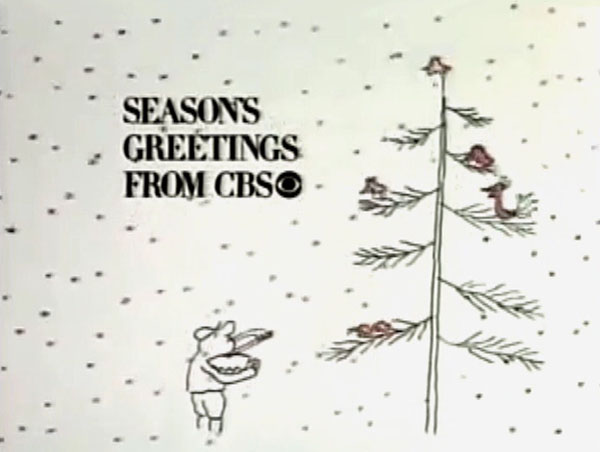
Willis Pyle animated this piece. Birds sing in a fir tree as snow falls around them. They stop as a man carrying a saw approaches. The man halts to play GOD REST YE MERRY GENTLEMEN on the saw. CHRISTMAS BIRDS is truly a tiding of peace and joy.
A high-profile Alka-Seltzer commercial designed by Blechman for Elektra Films in 1967 pushed him farther into the cultural limelight. Jack Dazzo animated the spot, where a narrator mediates an argument between a man and his stomach, which is understandably upset.
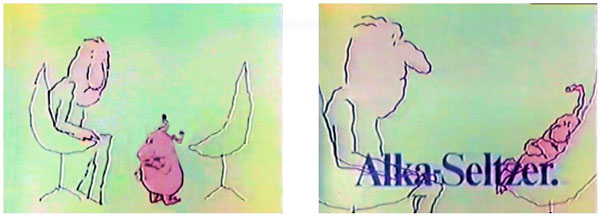
Blechman’s career as a magazine illustrator continued as he collaborated on teleblurbs with Elektra. New York City was the Mecca of cutting edge animation in that day. Work might sometimes be scarce, but it was seldom boring. Sure an animator could always go to Hollywood and pick up a regular check on the assembly line at Hanna-Barbera or DePatie Frelebg – but R. O. Blechman is not an animator, as I believe I’ve pointed out. He threw his hat into the whirlpool ring of Lee Savage, Lars Calonius, Faith and John Hubley, Fred Mogubgub, Ray Favata, Kim & Gifford, Pablo Ferro . . . a bubbling, volcanic, seismic landscape of creative energy tearing through the seams of television advertisement, fueled and funded by corporate dollars encouraging experimentation. Blechman worked exclusively with Elektra Films in this venue.
Aside from that, R. O. Blechman was too much a New Yorker to ply his trade elsewhere. Bob Blechman taught illustration in Manhattan at the School of Visual Arts. He married Moisha Kubinyi, daughter of noted painters Doris Hall and Kálmán Kubinyi. Blechman tutored his kids in French at the dinner table. All in all, an articulate minor celebrity welcome at any cocktail party worth attending. But, of course . . . NOT an animator.
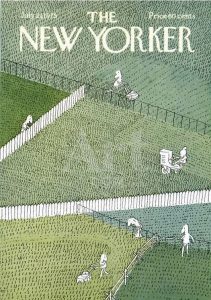 Why? Why would these accusations of being an animator dog R. O. Blechman through the decades? Certainly his choice to throw full creative weight behind the medium plays a large role. Elektra Films had burned bright and fast, being gone by the end of 1974. By then, R. O. Blechman counted twenty years as a working artist, successful practically before he even got started. Now, it seemed like he was just warming up. In 1975 Blechman bagged his long-sought prize with a cover of THE NEW YORKER.
Why? Why would these accusations of being an animator dog R. O. Blechman through the decades? Certainly his choice to throw full creative weight behind the medium plays a large role. Elektra Films had burned bright and fast, being gone by the end of 1974. By then, R. O. Blechman counted twenty years as a working artist, successful practically before he even got started. Now, it seemed like he was just warming up. In 1975 Blechman bagged his long-sought prize with a cover of THE NEW YORKER.
What to do next? If any one of you guessed – “produce an hour length PBS animated Christmas special” – well, you win! Blechman organized a Christmas special for the Public Broadcasting System called SIMPLE GIFTS, which meant assembling a crew. Blechman chose Michael Sporn as his assistant director and production manager. Sporn had recently been with the Hubleys under the wing of master animator Tissa David. She tackled a SIMPLE GIFTS sequence inspired by Virginia Woolf. The whole film was very classy. Children’s author Maurice Sendak wrote part of it.
It needs to be understood that while all toads are frogs, not all frogs are animators. Ida Greenberg signed on to supervise Blechman’s Ink & Paint Department. Ida Greenberg went back to Fleischer Studios’ Miami interlude. She’d done I&P for M-G-M in the Forties. Shamus Culhane had Ida Greenberg at Paramount Cartoons running I&P in the Sixties. She plied her trade at Pelican Films, and for Hubley Studios, working alongside Michael Sporn and Tissa David. Ida satisfied the exacting Richard Williams.
R. O. Blechman formed an animation studio called The Ink Tank at 2 West 47th Street. Ida Greenberg was made supervisor of the Checking Department. Blechman could no longer be in the Screen Cartoonists Guild, as he had become management. Pepe Ruiz morphed from representing him to a thorn in his side. While SIMPLE GIFTS was in production The Ink Tank turned out segments for SESAME STREET. Some television ads helped pay the bills as the PBS advancement ran out. Blechman personally wrote and directed SIMPLE GIFTS’ final segment, titled NO ROOM AT THE INN. Ed Smith animated the bulk of it, with Lucifer Guarnier assisting.
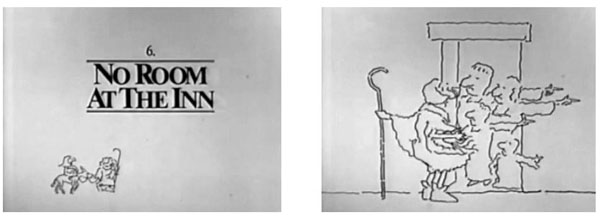
Lu Guarnier got his start with Leon Schlesinger Productions drawing Porky Pig for Bob Clampett cartoons. Guarnier was one of the first men drafted into the Army Signal Corps’ animation unit in Astoria, Queens. After the war Guarnier remained east, making himself valuable at Film Graphics. He served a few terms as president of the SCG local. U.P.A. put Lu Guarnier in charge of layouts. Hubley Studios engaged him for several films. Total Television let Guarnier direct episodes of KING LEONARDO AND HIS SHORT SUBJECTS.
Guarnier had been at it for more than a decade before Edwin Smith began pushing a pencil at Shamus Culhane Productions, then for Film Graphics, going on to become a fixture at Pelican Films. Ed Smith, for fifteen years editor of the union’s Top Cel newsletter, also did some stuff with Hubley Studios. He was cocksure and fast paced.
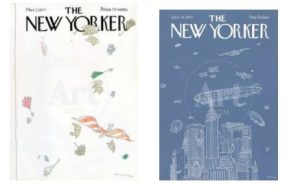 The Ink Tank entrenched R. O. Blechman in the world of animation as a producer and director. Surrounded by capable professionals, Bob was able to pursue illustration. 1977 turned out to be a banner year, with two THE NEW YORKER covers and SIMPLE GIFTS airing that December, escalating R. O. Blechman’s stock as a desirable dinner guest. The Ink Tank was free to focus on profits from teleblurbs. Bob and Moisha went to a documentary filmmakers’ conference in Milan, Italy, bringing about a chance encounter with a top PBS executive who’d appreciated SIMPLE GIFTS. Before Bob Blechman got done talking he’d planted the idea of producing a one hour animated version of a Stravinsky opera. R. O. Blechman may not be an animator, but in that shining moment he truly exhibited the masochistic tendencies of one.
The Ink Tank entrenched R. O. Blechman in the world of animation as a producer and director. Surrounded by capable professionals, Bob was able to pursue illustration. 1977 turned out to be a banner year, with two THE NEW YORKER covers and SIMPLE GIFTS airing that December, escalating R. O. Blechman’s stock as a desirable dinner guest. The Ink Tank was free to focus on profits from teleblurbs. Bob and Moisha went to a documentary filmmakers’ conference in Milan, Italy, bringing about a chance encounter with a top PBS executive who’d appreciated SIMPLE GIFTS. Before Bob Blechman got done talking he’d planted the idea of producing a one hour animated version of a Stravinsky opera. R. O. Blechman may not be an animator, but in that shining moment he truly exhibited the masochistic tendencies of one.
Committing to make a feature-length animation is a form of indentured servitude, a dance with the devil in all the details.
Those details were looked after by the Checking Department, which, at The Ink Tank was heavy with seasoned I&P pros. With Ida Greenberg was upbeat Sydel Solomon, old Fleischer Studios hand from the Thirties, M-G-M, Cineffects, Tempo Productions, Ben Harrison Productions, Shamus Culhane Productions, Archer Productions, Bill Sturm Studios, Lars Calonius Productions, Storyboard, Stars & Stripes Productions Forever, and a few other shops while freelancing. Sydel Solomon was as real as the deal got.
Selby Kelly, widow of Pogo cartoonist Walt Kelly, joined Ida and Sydel in Checking. Selby Daley, as she was once known, slung ink and paint at Disney for a decade before leaving during the big strike, moving through M-G-M, Lantz, Warner Brothers, and Hanna-Barbera. She did layouts for The Eames Office short THE EXPANDING AIRPORT concerning Washington D.C. Selby supervised checking for Sketchbook Film Productions and the U.S. State Department on THE GREAT RIGHTS. She earned an animation credit on Fine Arts Films’ feature SHINBONE ALLEY.
Rounding out this highly capable checking department was Irene Cerdas, who started inking at Terrytoons right out of high school, then on to Famous Studios and Zander’s Animation Parlour. Having Michael Sporn and these capable ladies over-seeing production on THE SOLDIER’S TALE freed Blechman up to illustrate, take meetings, design teleblurbs, sign paychecks, and try to figure out where money would come from to finance this feature film. Pepe Ruiz snapped at The Ink Tank’s heels over any perceived violation of union regulations, even shutting the place down briefly.
Blechman persevered. His wife Moisha acted as a color coordinator on the movie. Production spanned five years. Budgetary restraints prevented Bob from keeping any animator on THE SOLDIER’S TALE for very long, so work progressed in fits and starts. Bill Littlejohn did some animation. His experience stretched back to 1934 at Van Beuren Studios. Then on to M-G-M, Fine Arts Films, Hubley Studios. Littlejohn was a past president of the Hollywood union local. He was with Jay Ward Productions, and Bill Melendez on the Peanuts specials, and Crossbow Productions for a Carl Reiner/Mel Brooks project.
Ed Smith chipped in. Among the scenes he contributed was a balletic snow storm.

Fred Burns was a favored animator at Hubley Studios. John R. Gaug had worked for Richard Williams as well as Atkinson Film Arts in Ottawa, you know, the Care Bears people. Janet Perlman, a highly respected animator-writer–director with the National Film Board of Canada did the dreamlike silent movie sequence.
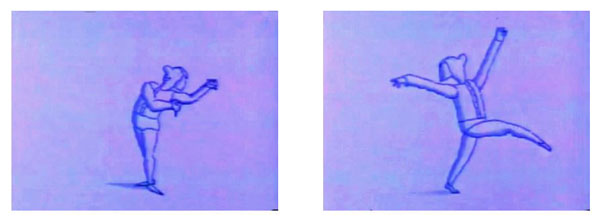
Tissa David did some elegant sequences on THE SOLDIER’S TALE, surprising Blechman with her surreal rendition of the Tango.
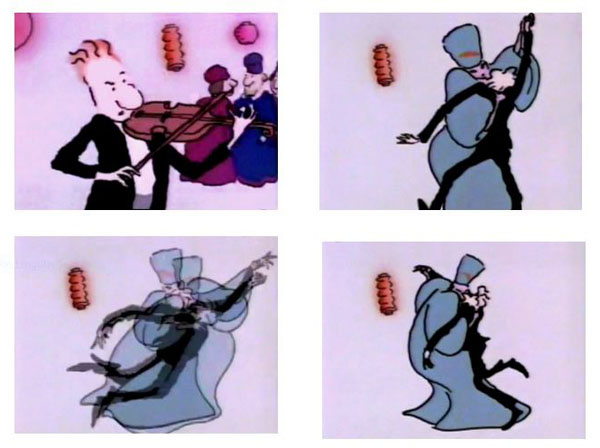
A younger group of animators mixed in. Tony Eastman, son of Disney and U.P.A. layout artist Phil Eastman among them. Yvette Kaplan had animated for the company that created SCHOOLHOUSE ROCK. Philadelphia born Dean Yeagle already had eight years in with Jack Zander. Maciek Albrecht entered the business on this film and found a home at The Ink Tank. And, of course, there was the inimitable Fred Mogubgub, whose unapologetically abstract flourishes added the proper nuance of absurdity.
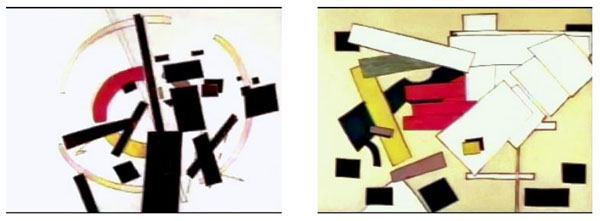
The assistant animators were no less impressive. Ed Cerullo had started in 1956 at Famous Studios, freelancing at Storyboard. Cerullo was with Pelican films in 1966 for THE NOSE, following Zander to the Animation Parlour for GNOMES. Helen Komar brought a solid resume – kicking it off at Famous Studios as an Assistant Animator. At Warner Brothers for THE INCREDIBLE MR. LIMPETT, and with Ralph Bakshi on FRITZ THE CAT. Komar managed animation for the Hubleys, proving good enough to rank as Assistant Animator for Richard Williams. Mary Szilagyl was an inbetweener for Richard Williams, and Assistant Animator for Perpetual Motion Pictures before diving into The Ink Tank.
They were all part of undertaking that fabulous task. Adapting Russian composer Igor Stravinsky’s 1918 stage piece L’Histoire du Soldat into a modernized cartoon movie for an audience of Americans to watch in the early 1980s just sounds hard. Imagine actually trying it!
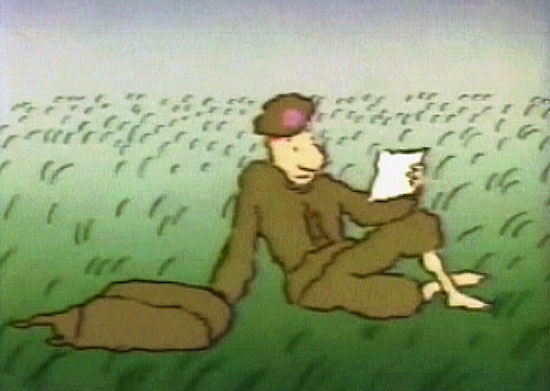
Like Washington at Valley Forge, R. O. Blechman kept . . . wait! That’s the wrong metaphor. I’m drifting away from my point, which is that R. O. Blechman is not an animator. Not so much as an assistant animator. Not even an inbetweener. What he is – is a respected author and illustrator, layout artist, designer, producer, and screenwriter, who directed one of the finest animated feature films of the Twentieth Century. I’m not laying it on too thick. THE SOLDIER’S TALE is that rare combination of intelligent and entertaining. Letting it fade into obscurity would be a shame and a loss.
As for R. O. Blechman not being an animator, well, with all the aforementioned taken into consideration, it might be nice if you real animators bestowed an honorary degree upon him.
. . . I’m just saying!


 BOB COAR made his way in this world as a muralist and sign painter, illustrating on just about every surface imaginable. A life-long fan of animation, he is currently searching for digital, or actual, copies of Top Cel.
BOB COAR made his way in this world as a muralist and sign painter, illustrating on just about every surface imaginable. A life-long fan of animation, he is currently searching for digital, or actual, copies of Top Cel. 



































Igor Stravinsky composed few operas but many ballets, and “The Soldier’s Tale” is one of the latter, not an opera. The fact that there aren’t any vocal parts in it is a dead giveaway. The story is about a soldier who makes a deal with the devil over his violin and his soul, fully sixty years before Charlie Daniels tackled the same subject matter in “The Devil Went Down to Georgia”, which isn’t an opera either.
But while “L’histoire du soldat” is NOT an opera, “The Juggler of Our Lady” IS. It was a very old story long before Blechman got his hands on it, and around the turn of the last century it was adapted into an opera by Jules Massenet, composer of “Thais”, “Manon”, “Werther”, and other operatic standards. “Le jongleur de Notre Dame” is seldom staged owing to the worldwide scarcity of opera singers who can juggle. Another problem is the lack of female roles: there are only two, both of them angels, who sing offstage in the very last scene and nowhere else. (Our Lady herself is a mute role.) I’m not familiar with this opera, but from what I know of Massenet’s music it’s bound to be much more sumptuously beautiful than the sparsely scored woodwind quintet music that Gene Deitch insisted on for the cartoon.
“Simple Gifts” is the title of a Shaker hymn. I don’t know whether it was played in the PBS Christmas special of that name, but Aaron Copland included a set of variations on the hymn tune in his 1944 ballet “Appalachian Spring”, which is not an opera.
I enjoyed this week’s post very much. I suppose the reason Blechman has been erroneously called an animator is simply that there are hardly any cartoon directors who never were animators. Bill Hanna is the only other one I can think of offhand.
Fred Mogubgub… Now where else do I know that name from? Did I see it in MAD magazine?
I’ll get to Mogubgub soon.
Howard Beckerman told me that Jack Dazzo animated that iconic Christmas spot Blechman designed.
Blechman proof read this article.
Devon – Maybe Howard was referring to the OTHER CBS X-mas spot with Santa and the little girl. The “Trees” was most certainly animated by Willis Pyle. I was honored to retransfer the original 35mm OCN/negative of the “Trees” spot in 1990. CBS wanted to include it on a “I Love Lucy/Holiday VHS Cassette. Lou Dorfsman had the original element pulled from their vaults and we re-did it at The Tapehouse.
Fine piece.
But when you say “Gene Deitch decided to make THE JUGGLER OF OUR LADY as a cartoon, giving it the full Cinerama treatment,” I believe you mean “the full CinemaScope treatment.”
Okay.
Fantastic post Bob, your research is impressive! I remember that CBS Christmas interstitial, just not sure if from a later year or not but I’m ancient enough I may have seen it when first broadcast, which would make it one of my earliest memories.
I’m told they ran it for years.
They DID. I saw it around 1970.
They did. There’s another one, involving a department store Santa, that I won’t give away, but it’s not as affecting.
Animator or not, R.O. Blechman is a genius. “The Juggler of Our Lady” belongs in everybody’s Christmas cartoon collection.
Supposedly, R.O. was quite meticulous in designing his characters, using many layers of translucent tracing paper, he would work and re-work one little wiggly line at a time, until he got JUST the wiggle that he wanted. Many animators probably just whipped out the wiggles, without really caring about how the lines were designed. For a while in the late 1970s there was a rash of ersatz “Blechman” commercials going the rounds. I worked on a few for Exide-Willard Car Batteries. My friend Mike Sanger and I used to do a 45 foot wiggly line commercial over a weekend. The only time we fussed over the lines was when we were coming out of an active phase of the motion into a “hold”. Then we made sure the lines and the breaks in the lines, were inbetweened carefully into the ultimate pose. The “Blechman” stuff was fun for awhile, but we knew we weren’t doing the real thing, just ripping it off. The style kind of ruins your drawing, too. Great post, Mr. Coar, learned a lot from it.
Really nice article, Bob. I appreciate your focus on R. O. as an independent filmmaker when he’s largely positioned as a commercial artist. Another of his 1960s (maybe early 70s) shorts is “Abraham & Isaac” with a great soundtrack by Pete Seeger for whom Bob also illustrated the cover of “God Bless This Grass”. They both shared a love for the Hudson Valley, too.
I may be mistaken on this but I believe Michael Sporn stopped working on The Soldier’s Tale pretty early on and George Griffin stepped in for him.
great article.
and a great documentation of animation in new york.
thank you.
Thanks for a fascinating and well-written piece about an artist’s whose work I admired even as a child. Blechman’s deceptively simple style, at once naive yet sophisticated, really typifies the best animation of the sixties and early seventies to me. I remember both the CBS spot and the Alka-Seltzer commercial and some of his New Yorker work but not the Stravinsky animation although I will definitely be watching it.
The distinctintive squiggle style really gives these pieces a curious, frizzly charm and reminds me of later “Peanuts” when Charles Schultz could no longer draw with a steady hand. Schultz hated the way his later drawings looked but I thought they gave his late work a certain freshness.
All this just makes me miss cel animation and loathe the sterile CGI variety that much more…
A year later, and Wikipedia STILL lists him as an animator.
Yet another reason why you should always check reliable sources…like here!